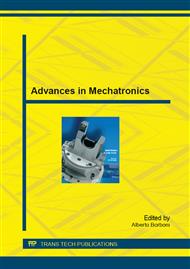[1]
K. Mańczak, Technika planowania eksperymentu. (Engineering of Experiment Planing– in polish). Warszawa WNT, (1976).
Google Scholar
[2]
Z. Polański, Planowanie doświadczeń w technice, (Scheduling of Experiment in Technics – in polish), PWN Warszawa, (1984).
Google Scholar
[3]
A. Asilturk, L Elik, E. Canli and G. Onal, Regression Modeling of Surface Roughness in Grinding. Advanced Materials Researc 271-273 (2011) 34-39.
DOI: 10.4028/www.scientific.net/amr.271-273.34
Google Scholar
[4]
M. Nalbant, H. Gokkaya, and I. Tokta, Comparison of Regression and Artificial Neural Network Models for Surface Roughness Prediction with the Cutting Parameters in CNC Turning. Hindawi Publishing Corporation Modelling and Simulation in Engineering, Volume 2007, Article ID 92717, 14 pages.
DOI: 10.1155/2007/92717
Google Scholar
[5]
R. Das, M. K. Pradhan, Comparison of Regression and Feed Forward Network Models for Surface Roughness Prediction with EDMed Surface Proc of International Conference on Emerging & Futuristic System and Technology (ICE-FST'09) Laxmi Devi Institute of Engineering & Technology, Chikaani, Alwar (Raj. ) april 09 -11, (2009).
Google Scholar
[6]
M. K. Pradhan, R. Das, C. K. Biswas, Prediction of Surface Roughness in Electrical Discharge Machining of D2 Steel using Regression and Artificial Neural Networks Modeling, Journal of Machining and Forming Technologies (JoMFT), Nova Science Publishers, 2/1-2 (2009).
Google Scholar
[7]
T. Szecsi, Cutting Force Modeling using Artificial Neural Networks. Journal of Materials Processing Technology, 92-93 (1999) 344-349.
DOI: 10.1016/s0924-0136(99)00183-1
Google Scholar
[8]
S. Tasdemir, S. Neseli, S. Sarıtas and S. Yaldız, Prediction of Surface Roughness Using Artificial Neural Network in Lathe, ACM International Conference Proceeding Series; Proceedings of the 9th International Conference on Computer Systems and Technologies and Workshop for PhD Students in Computing, 374, (2008).
DOI: 10.1145/1500879.1500925
Google Scholar
[9]
H. Oktem, T. Erzurumlu and F. Erzincanli. Prediction of Minimum Surface Roughness in End Milling Mold Parts using Neural Network and Genetic Algorithm. Materials & Design, 27/9 (2006) 735-744.
DOI: 10.1016/j.matdes.2005.01.010
Google Scholar
[10]
M.F.F. A. Rashid and M.R. Abdul Lani Surface Roughness Prediction for CNC Milling Process using Artificial Neural Network. Proceedings of the World Congress on Engineering London, vol III (2010).
Google Scholar
[11]
A. Olaru, S. Olaru, D. Paune and A. Ghionea, Assisted Research of the Neural Network, Advanced Materials Research, 463 – 464 (2012) 1098-1011.
DOI: 10.4028/www.scientific.net/amr.463-464.1098
Google Scholar
[12]
A. Olaru, S. Olaru, Assisted Research of the Neural Network with LabVIEW Instrumentation. Advanced Materials Research, 403 – 408 (2011) 97-104.
DOI: 10.4028/www.scientific.net/amr.403-408.97
Google Scholar
[13]
A. C. Combrie, Comparing Neural Networks and Regression Models for Ozone Forecasting Journal of the Air & Waste Management Association 47 (2012) 653- 663.
DOI: 10.1080/10473289.1997.10463925
Google Scholar
[14]
www. statsoft. com/Portals/0/Support/Download/STATISTICA_Quick_Reference. pdf.
Google Scholar
[15]
M. Kawalec, Fizyczne i technologiczne zagadnienia przy obróbce z małymi grubościami warstwy skrawanej. (Physical and Technological Issues in Machining with Small Thickness of Cutting Layer – in polish). Rozprawy nr 106, Politechnika Poznańska, (1979).
Google Scholar
[16]
E. Miko, Konstytuowanie mikronierówności powierzchni metalowych obrobionych narzędziami o określonej stereometrii. ( Constitution Ssperities of Metal Surfaces Machined using Tools with Particular Stereometry – in polish), Wydawnictwo Politechniki Świętokrzyskiej. Seria: Monografie, Studia, Rozprawy 46, 2006, Kielce.
Google Scholar
[17]
B. Storch, Zjawiska przykrawędziowe i monitorowanie chropowatości powierzchni po obróbce jednoostrzowej. (Phenomena-Edge and Monitoring of Surface Roughness after Machining Single Point – in polish). Politechnika Koszalińska, Monografia Wydziału Mechanicznego nr 124, 2006, Koszalin.
Google Scholar


